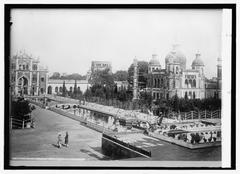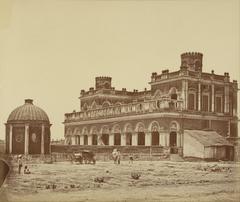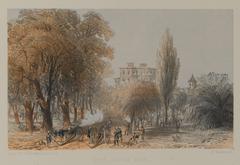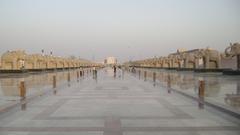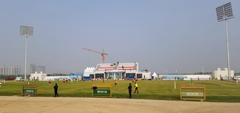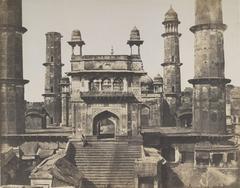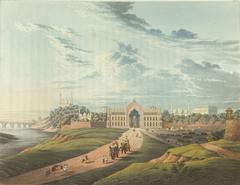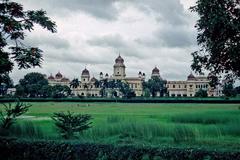
Visiting Musa Bagh: Hours, Tickets, and Tips
Publication Date: 19/07/2024
Introduction to Musa Bagh
Nestled in the historic city of Lucknow, India, Musa Bagh represents a fascinating blend of Mughal and European architectural elements, serving as a silent yet poignant witness to the city’s rich cultural heritage and turbulent past. Commissioned by Nawab Saadat Ali Khan II, who ruled from 1798 to 1814, Musa Bagh was originally designed as a summer retreat and pleasure garden. The estate’s name, which translates to ‘Moses Garden,’ reflects a confluence of cultural influences in its very nomenclature (source).
Constructed during the peak of the Nawabi era, Musa Bagh’s sprawling gardens, intricate waterworks, and grand pavilions stand as a testament to the architectural grandeur associated with the Nawabs of Awadh. However, the estate is not merely an architectural marvel; it holds significant historical importance due to its role during the Indian Rebellion of 1857, where it served as a strategic location for both British forces and Indian rebels (source). Despite the heavy damage it sustained during the conflict, Musa Bagh remains a crucial landmark for historians, tourists, and anyone interested in the rich tapestry of India’s past.
In recent years, efforts by local heritage organizations and the Archaeological Survey of India (ASI) have sought to preserve and restore Musa Bagh, ensuring that future generations can continue to appreciate its historical and cultural significance (source). This guide aims to provide a comprehensive overview of Musa Bagh, covering its origins, architectural style, historical significance, visitor information, and much more.
Contents
- Introduction
- Origins and Construction
- Architectural Style
- Historical Significance
- Post-Rebellion Era
- Cultural Impact
- Preservation Efforts
- Visitor Information
- Visiting Hours
- Tickets
- Accessibility
- Visitor Experience
- Guided Tours
- Visitor Guidelines
- Photography Spots
- Nearby Attractions
- FAQ
- Conclusion
A Complete Guide to Visiting Musa Bagh - History, Tickets, and Tips
Introduction
Discover the historical and architectural wonder of Musa Bagh, a stunning testament to the Nawabs of Awadh in Lucknow, India. This guide will cover its rich history, visitor information, and tips for making the most of your visit.
Origins and Construction
Musa Bagh, located in the historic city of Lucknow, India, is a testament to the architectural grandeur of the Nawabs of Awadh. The construction of Musa Bagh was commissioned by Nawab Saadat Ali Khan II, who ruled from 1798 to 1814. The estate was designed as a pleasure garden and a summer retreat, reflecting the opulence and aesthetic sensibilities of the Nawabs. The name “Musa Bagh” translates to “Moses Garden,” indicating a blend of cultural influences in its nomenclature.
Architectural Style
The architectural style of Musa Bagh is a blend of Mughal and European elements, a hallmark of the Nawabi architecture of Lucknow. The estate features sprawling gardens, intricate waterworks, and grand pavilions. The main building, although now in ruins, showcases the use of stucco and intricate carvings that were prevalent during the period. The design of Musa Bagh was intended to create a serene and luxurious environment, with lush greenery and water features providing a cool respite from the summer heat.
Historical Significance
Musa Bagh holds significant historical importance due to its association with the Indian Rebellion of 1857. During the uprising, the estate served as a strategic location for both the British and the Indian rebels. The gardens and buildings of Musa Bagh witnessed intense battles, and the estate was heavily damaged during the conflict. The ruins of Musa Bagh stand as a silent witness to the turbulent events of 1857, marking it as a site of historical and cultural importance.
Post-Rebellion Era
After the suppression of the rebellion, Musa Bagh fell into disrepair. The British colonial administration did not prioritize the restoration of the estate, and it gradually deteriorated. Despite its dilapidated state, Musa Bagh continued to be a symbol of the rich cultural heritage of Lucknow. Efforts to preserve and restore the site have been sporadic, but it remains an important landmark for historians and tourists alike.
Cultural Impact
Musa Bagh has had a lasting impact on the cultural landscape of Lucknow. The estate is often referenced in literature and historical accounts of the Nawabi era and the 1857 rebellion. It serves as a poignant reminder of the architectural and cultural achievements of the Nawabs of Awadh. The gardens and ruins of Musa Bagh continue to inspire artists, writers, and historians, contributing to the cultural richness of Lucknow.
Preservation Efforts
In recent years, there have been efforts to preserve and restore Musa Bagh. Local heritage organizations and the Archaeological Survey of India (ASI) have undertaken initiatives to protect the site from further decay. These efforts include structural stabilization, conservation of the remaining architectural elements, and the promotion of Musa Bagh as a heritage tourism destination. The preservation of Musa Bagh is crucial for maintaining the historical and cultural fabric of Lucknow.
Visitor Information
Visiting Hours
Musa Bagh is open to visitors from 9 AM to 5 PM daily. It is advisable to check for any changes in timings on local tourism websites before planning your visit.
Tickets
The entry fee for Musa Bagh is modest, with tickets priced at INR 20 for Indian citizens and INR 100 for foreign tourists. Children below the age of 12 can enter for free.
Accessibility
While the site has partially accessible areas, some parts may be challenging for visitors with mobility issues due to the ruins’ condition. It is recommended to contact local guides or authorities for more information on accessibility.
Visitor Experience
Guided Tours
Guided tours are available for visitors who wish to gain deeper insights into the history and significance of Musa Bagh. These tours are conducted by knowledgeable guides who provide detailed historical context and anecdotes about the site.
Visitor Guidelines
Visitors are encouraged to respect the historical significance of Musa Bagh by adhering to guidelines such as not littering, avoiding damage to the ruins, and following marked paths. These measures help in the preservation of the site.
Photography Spots
Musa Bagh offers numerous picturesque spots ideal for photography. The intricate architectural details, lush gardens, and serene environment provide a perfect backdrop for capturing memories. Visitors are encouraged to share their experiences on social media using the hashtag #MusaBaghLucknow.
Nearby Attractions
Lucknow boasts several other historical and cultural sites worth visiting:
- Bara Imambara - A grand complex with a mosque, a labyrinth, and an impressive central hall.
- Chota Imambara - Known for its stunning decorations and chandeliers.
- Rumi Darwaza - An iconic gateway that exemplifies Awadhi architecture.
- Hazratganj Market - Perfect for shopping and experiencing local cuisine.
FAQ
What are the best times to visit Musa Bagh?
The best times to visit Musa Bagh are during the cooler months from October to March. The pleasant weather enhances the experience of exploring the gardens and ruins.
Is Musa Bagh accessible for disabled visitors?
While some areas are partially accessible, the ruins’ condition may pose challenges for visitors with mobility issues. It is recommended to check with local authorities for the latest accessibility information.
Conclusion
Musa Bagh stands as a testament to the rich history and cultural heritage of Lucknow. Its architectural beauty, historical significance, and cultural impact make it a must-visit destination for those interested in the history of India. The ongoing preservation efforts ensure that Musa Bagh will continue to be a source of inspiration and education for future generations. Download the Audiala app for more historical insights and follow us on social media for updates and travel tips.
Summary and Key Points
Musa Bagh stands as a monumental testament to the rich history, architectural splendor, and cultural heritage of Lucknow. From its origins as a luxurious summer retreat for the Nawabs of Awadh to its significant role in the Indian Rebellion of 1857, the estate encapsulates a wide array of historical narratives and cultural influences. Despite the ravages of time and conflict, the ruins of Musa Bagh continue to inspire awe and reflection, serving as a poignant reminder of the past.
Recent preservation efforts led by the Archaeological Survey of India (ASI) and local heritage organizations have been instrumental in safeguarding this historical treasure. These initiatives ensure that Musa Bagh remains accessible to historians, tourists, and future generations, thereby maintaining its relevance in India’s cultural and historical landscape (source).
Visiting Musa Bagh offers a unique opportunity to delve into the architectural brilliance of the Nawabi era and the turbulent events of 1857, while also enjoying the serene beauty of its Mughal-style gardens. Whether you are a history buff, an architecture enthusiast, or a curious traveler, Musa Bagh promises an enriching and unforgettable experience. Plan your visit today and immerse yourself in the rich tapestry of Lucknow’s heritage.
